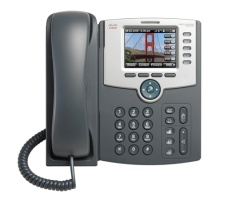The Cisco SPA525G VoIP phone is the top end phone in the Cisco small business series. The series is commonly used by Hosted VoIP companies in their phone selections. Consistent with the entire line up of phones, the SPA525 model is very user friendly from both the system administrator and the end user standpoint. Being a top end phone, you would expect some nice additional features for the approximately $100 in additional cost.
The Great:
- This phone has a very crisp color screen. You can upload a picture or
 company logo to the screen’s background for a nice personalized touch. The screen is larger than the other, monochrome backlit phones in the series.
company logo to the screen’s background for a nice personalized touch. The screen is larger than the other, monochrome backlit phones in the series. - With the SPA525, you can connect a blue tooth headset to use as a wireless option. This is a more elegant approach for a cordless headset for these models of phones. The other phones in the line up only provide for a corded headset to work with the headset control on the phone. If you were to attach a cordless headset to the other phones, you have to loop it with the handset and apply a lifter to the phone. So, the blue tooth option is awesome with the SPA525.
The Good:
- The SPA525 is also WiFi capable, thus a corded Ethernet connection is not necessary for this phone. Although the phone’s performance will be subject to the WiFi strength, potential interference, and access point capacity, it does offer a good alternative to Ethernet wiring to current unwired workstations.
- A very cool feature of the SPA525 is that it can record calls on-demand to a jump drive that can be plugged into the USB port on the phone. You can listen to the calls after recording or safe the files to your computer from the jump drive. The only reason why this isn’t a “great” feature is that it may be duplicative to the recording service many hosted VoIP providers already provide. However, if your hosted VoIP provider charges extra for recordings, this will allow you to take control of the recording yourself and eliminate the extra charge.
The Not So Good:
- This phone has 5 lines, which is an upgrade from the 4 line base model, SPA504, but less than the 8 line SPA508. In my mind, with the bigger screen, they could have easily made this a ten line phone. Some hosted providers can program the lines to be speed dials to other users and set it so you can see when they are currently on the phone. You only need two to three “lines” for Direct Dials or main line rings, so having more buttons available to speed dial or see the status of other associates.
- There is a definite premium for the top of the line phone. Generally speaking, these cost about $100 more than the base phone. If the dollars don’t seem too bad, the percentage of increase would – 83%! Ouch!
At sipVine, the majority of phones we utilize in our installations are the Cisco SPA500 series. Perhaps a sign of economic turnaround is that more companies have been willing to pay the premium for the nicer desk phones. When compared to the desk phones attached to popular on-site systems, they still are very affordable.
About the author: Mark Greim is the Vice President of Sales and Marketing at sipVine, a provider of a variety of digital phone solutions and services. Mark has extensive experience working for start-up or entrepreneurial organizations and a passion for affordable, reliable, and purposeful technology solutions in those environments.



